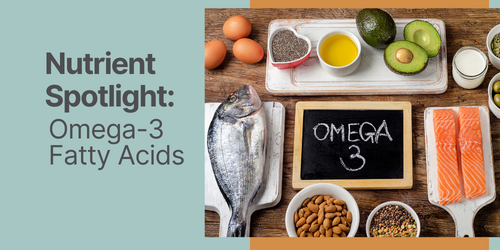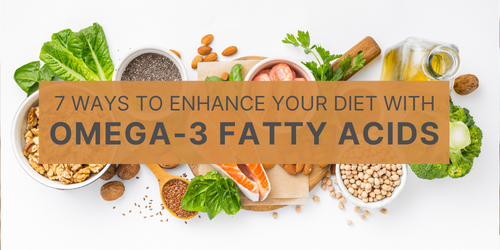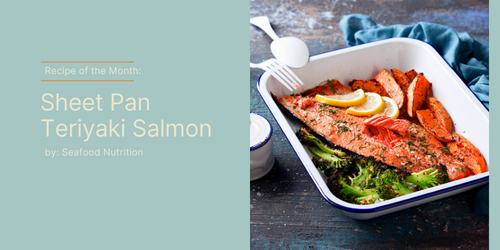With a profound passion for promoting health and well-being through nutrition, I am dedicated to translating complex nutritional science into digestible content and sharing it with clients. In this month’s newsletter, I’m doing a special nutrient spotlight on the incredible benefits and importance of omega-3 fatty acids – a key player in heart health, cognitive function, and inflammation control.
Whether you are a health enthusiast, a fellow nutrition professional, or someone seeking to enhance your understanding of the nutritional landscape, this newsletter aims to empower and inspire. Together, we will navigate the intricate details of omega-3 fatty acids, unraveling their potential to elevate your health and vitality.
Keep reading to unlock the benefits of omega-3 fatty acids, explore foods rich in this nutrient powerhouse, and discover easy ways to enhance the nutrient profile of your meals.
-Stephanie
|
|
|
Elevate Your Health With Omega-3 Fatty Acids
|

What are omega-3 fatty acids?
Omega-3 fatty acids, commonly called omega-3s or essential fatty acids, are polyunsaturated fats (PUFAs) crucial in various bodily functions. They are essential because the body cannot produce what it needs independently; therefore, you need to get omega-3 fatty acids from food or supplements.
Why are omega-3 fatty important?
Omega-3 fatty acids support the health of many essential body functions, including cardiovascular, immune, and brain functions. They play a vital part in providing structure for your cells and supporting the interaction and function of the cells in your body. In addition, omega-3s offer your body energy (calories) while supporting the cardiovascular and endocrine systems.
Benefits of omega-3 fatty acids include:
- Support heart health
- Lower triglycerides
- Increase HDL cholesterol (good cholesterol)
- Decrease blood pressure
- Reduce inflammation
- Improve cognitive function and prevent cognitive decline
- Support prenatal health and infant/child development
Omega-3 fatty acids may:
- Lower the risk of cardiovascular diseases and blood clots
- Decrease the risk of some cancers, including breast cancer
- Reduce the risk of Alzheimer's disease, dementia, and age-related macular degeneration
Where to find omega-3 fatty acids:
There are types of omega-3 fatty acids including EPA (eicosapentaenoic acid), DHA (docosahexaenoic acid), and ALA (alpha-linolenic acid).
- EPA and DHA are primarily found in fatty fish.
- Plants are the primary source of ALA.
Your body can convert some of the ALA you get from food into EPA and DHA, but only a tiny amount. Therefore, consuming EPA and DHA from food or supplements is essential.
Fatty fish such as mackerel, salmon, herring, tuna, halibut, and sardines are among the best sources of omega-3 fatty acids. Plant-based foods rich in omega-3 fatty acids include flax, hemp, chia, and walnuts.
How much should you consume?
The recommendations for how much omega-3 fatty acids each needs vary based on age, sex, and health factors. For example, pregnant or breastfeeding women may benefit from more omega-3s than women the same age who are not pregnant or breastfeeding.
The American Heart Association recommends that people with heart disease consume 1,000 mg of EPA and DHA daily. People without heart disease consume at least two servings of fish per week (6 ounces to 8 ounces total) or 250 - 500 mg of EPA and DHA.
Research supports the consumption of more omega-3 fatty acids; however, the NHI and FDA suggest people limit themselves to 3,000 mg of omega-3 per day unless otherwise specified by a medical professional. Talk with your healthcare provider if you may benefit from consuming more.
Risk and side effects:
While there is abundant evidence supporting the benefits of omega-3s, more does not mean better. High levels of these fatty acids can cause bleeding or other issues. Consult your healthcare provider if you have 3 grams or more of omega-3 fatty acids daily.
|
|
|
7 Ways to Enhance Your Diet With Omega-3 Fatty Acids
|

- Aim for at least two servings of fatty fish per week. Include fatty fish such as salmon, mackerel, sardines, and trout.
- Enhance meals and snacks with plant-based omega-3. Sprinkle chia seeds or ground flaxseeds on your yogurt, oatmeal, or salads. Snack on walnuts, or add them to your cereals, salads, or yogurt.
- Include more whole soy foods, such as edamame, tofu, and soy nuts. Soy products are a good source of ALA.
- If you consume meat, choose lean grass-fed meat, which has a higher omega-3 content than conventionally raised meat.
- Experiment with recipes that feature omega-3-rich ingredients. Grilled salmon, chia seed pudding, or flaxseed smoothies are delicious options.
- When cooking, retain the nutritional value of omega-3-rich foods by baking, grilling, or steaming.
- Pay attention to food labels to identify products fortified with omega-3s or those naturally rich in these fatty acids.
While it is ideal to get EPA, DHA, and ALA by eating foods rich in omega-3 fatty acids, adding an omega-3 supplement such as algal, krill, fish, or cod liver oil may be beneficial. Before you add supplements to your routine, you should consult with a healthcare professional. Working with a registered dietitian can help determine the best supplement for your health needs and goals. When choosing a supplement, select a brand that has been third-party certified for quality and safety. Contact me today to schedule a consult and receive a personalized nutrition and supplement plan.
|
|
Featured Recipe
Sheet Pan Teriyaki Salmon
|

Recipe by: Seafood Nutrition
Sheet-pan meals are great for busy weeknight dinners because they cook quickly, and they’re easy to swap out for seasonal vegetables or what you have on hand.
Servings 4, Prep Time 5 minutes, Cook Time 10 minutes, Total Time 15 minutes
Ingredients:
- 2 cups Diced Sweet Potatoes, about ½ inch cubes
- 1 TBSP Sesame Oil, divided Salt, to taste
- 2/3 Pepper, to taste
- 4 cups Broccoli Florets
- ½ cup Thinly Sliced Red Onion
- Teriyaki Sauce (Kevin’s Natural Foods and Primal Kitchen offer low-sugar, gluten-free pre-made options)
Directions:
- Preheat oven to 400°F. Line a sheet pan with parchment paper and set aside while prepping the ingredients.
- In a medium-sized bowl, toss together the diced sweet potatoes and 1 ½ tsp sesame oil and coat evenly. Transfer sweet potatoes to a parchment-lined sheet pan and season with salt and pepper.
- Place the sweet potatoes in the oven and roast for about 20 minutes, flipping the pieces at 10 minutes.
- Once the sweet potatoes are cooked and softened when pierced with a fork, remove them from the oven and distribute them on the pan with space for the salmon. Place the salmon filets on the sheet pan then season with salt and pepper.
- In a medium bowl, combine the broccoli, red onion, and remaining 1 ½ teaspoon sesame oil. Mix well and season with salt and pepper.
- Sprinkle the broccoli-onion mixture around the salmon and sweet potatoes.
- Reserve 1/2 cup of the teriyaki sauce for garnish; drizzle the remaining sauce over the salmon and vegetables.
- Place the sheet pan back into the oven and bake for 15 minutes or until the salmon reaches 145°F and the broccoli is cooked.
- Serve with the remaining sauce and a sprinkle of sesame seeds.
|
|
|
Be Inspired
|
|

|
|
|
About SO Nutrition
|
 Stephanie Leipprandt Ouellette, MBA, RDN, LD
Stephanie Leipprandt Ouellette, MBA, RDN, LD Stephanie has been working in the field of nutrition and dietetics since 1995. She earned a Bachelor of Science degree in Dietetics from Michigan State University, completed an Approved Pre-Professional Practice Program at Western Michigan University and earned a Master of Business Administration from Baker College. She’s been a Registered Dietitian Nutritionist since 1996 and licensed in Texas since 2007. In 2008, Stephanie earned her certification in Childhood and Adolescent Weight Management. Stephanie has extensive clinical & managerial experience, both in corporate settings and in the community. Now she wants to share her knowledge with you, because most (if not all) nutritional habits begin at home.
Stephanie and her family reside in Katy, Texas
|
|
| |
Copyright © 2024 Customized Nutrition Newsletters, All rights reserved.
|
|
| |
|
|